The Influence of Chemical Component Distribution on the Radiometric Properties of Particle Aggregates
Abstract
1. Introduction
2. Methods
2.1. Particle Aggregate
2.2. Refractive Index
2.2.1. Mode A
2.2.2. Mode B
2.3. Radiometric Properties Computation
3. Results and Discussion
3.1. Distribution Mode
3.2. Minor Particle Position
3.3. Volume Fraction of Minor Components
4. Conclusions
Author Contributions
Funding
Acknowledgments
Conflicts of Interest
References
- Modest, M.F. Radiative Heat Transfer; Academic Press: San Diego, CA, USA, 2013. [Google Scholar]
- Doner, N.; Liu, F. Impact of morphology on the radiative properties of fractal soot aggregates. J. Quant. Spectrosc. Radiat. Transf. 2017, 187, 10–19. [Google Scholar] [CrossRef]
- Kolokolova, L.; Nagdimunov, L.; Mackowski, D. Light scattering by hierarchical aggregates. J. Quant. Spectrosc. Radiat. Transf. 2018, 204, 138–143. [Google Scholar] [CrossRef]
- Yon, J.; Liu, F.; Morán, J.; Fuentes, A. Impact of the primary particle polydispersity on the radiative properties of soot aggregates. Proc. Combust. Inst. 2018. [Google Scholar] [CrossRef]
- Liu, D.; Duan, Y.-Y.; Yang, Z.; Yu, H.-T. Theoretical predictions of spectral emissivity for coal ash deposits. J. Heat Transf. 2014, 136, 072701. [Google Scholar] [CrossRef]
- Amin, H.M.; Roberts, W.L. Multi-Angle Light Scattering for Investigating Soot Particle/Aggregate Parameters in a Counterflow Flame at Elevated Pressures. In Proceedings of the 10th U.S. National Combustion Meeting Organized by the Eastern States Section of the Combution Institute, College Park, MD, USA, 23–26 April 2017. [Google Scholar]
- Cepuritis, R.; Garboczi, E.J.; Ferraris, C.F.; Jacobsen, S.; Sørensen, B.E. Measurement of particle size distribution and specific surface area for crushed concrete aggregate fines. Adv. Powder Technol. 2017, 28, 706–720. [Google Scholar] [CrossRef]
- Friedlander, S.K.; Smoke, D. Haze: Fundamentals of Aerosol Dynamics; Oxford University Press: New York, NY, USA, 2000. [Google Scholar]
- Cheng, X.; Sun, R.; Yin, L.; Chai, Z.; Shi, H.; Gao, M. Light-Triggered Assembly of Gold Nanoparticles for Photothermal Therapy and Photoacoustic Imaging of Tumors In Vivo. Adv. Mater. 2017, 29. [Google Scholar] [CrossRef]
- Loyalka, S. Mechanics of aerosols in nuclear reactor safety: A review. Prog. Nuclear Energy 1983, 12, 1–56. [Google Scholar] [CrossRef]
- Bentley, M.S.; Schmied, R.; Mannel, T.; Torkar, K.; Jeszenszky, H.; Romstedt, J.; Levasseur-Regourd, A.-C.; Weber, I.; Jessberger, E.K.; Ehrenfreund, P.; et al. Aggregate dust particles at comet 67P/Churyumov–Gerasimenko. Nature 2016, 537, 73. [Google Scholar] [CrossRef] [PubMed]
- Chýlek, P.; Videen, G.; Geldart, D.; Dobbie, J.S.; Tso, H. Effective medium approximations for heterogeneous particles. In Light Scattering by Nonspherical Particles: Theory, Measurements, and Applications; Academic Press: San Diego, CA, USA, 2000. [Google Scholar]
- Barrera, R.G.; García-Valenzuela, A. Coherent reflectance in a system of random Mie scatterers and its relation to the effective-medium approach. J. Opt. Soc. Am. A 2003, 20, 296–311. [Google Scholar] [CrossRef]
- Kocifaj, M.; Videen, G. Optical behavior of composite carbonaceous aerosols: DDA and EMT approaches. J. Quant. Spectrosc. Radiat. Transf. 2008, 109, 1404–1416. [Google Scholar] [CrossRef]
- Mackowski, D.W.; Mishchenko, M.I. Direct simulation of extinction in a slab of spherical particles. J. Quant. Spectrosc. Radiat. Transf. 2013, 123, 103–112. [Google Scholar] [CrossRef]
- Kahnert, M.; Nousiainen, T.; Lindqvist, H. Models for integrated and differential scattering optical properties of encapsulated light absorbing carbon aggregates. Opt. Express 2013, 21, 7974–7993. [Google Scholar] [CrossRef]
- Liu, C.; Panetta, R.L.; Yang, P. Inhomogeneity structure and the applicability of effective medium approximations in calculating light scattering by inhomogeneous particles. J. Quant. Spectrosc. Radiat. Transf. 2014, 146, 331–348. [Google Scholar] [CrossRef]
- Mishchenko, M.I.; Dlugach, Z.M.; Zakharova, N.T. Direct demonstration of the concept of unrestricted effective-medium approximation. Opt. Lett. 2014, 39, 3935–3938. [Google Scholar] [CrossRef]
- Kahnert, M. Modelling radiometric properties of inhomogeneous mineral dust particles: Applicability and limitations of effective medium theories. J. Quant. Spectrosc. Radiat. Transf. 2015, 152, 16–27. [Google Scholar] [CrossRef]
- Yu, H.; Liu, D.; Duan, Y.; Yang, Z. Applicability of the effective medium theory for optimizing thermal radiative properties of systems containing wavelength-sized particles. Int. J. Heat Mass Transf. 2015, 87, 303–311. [Google Scholar] [CrossRef]
- Zhuromskyy, O. Applicability of Effective Medium Approximations to Modelling of Mesocrystal Optical Properties. Crystals 2016, 7, 1. [Google Scholar] [CrossRef]
- Mishchenko, M.I.; Dlugach, J.M.; Liu, L. Applicability of the effective-medium approximation to heterogeneous aerosol particles. J. Quant. Spectrosc. Radiat. Transf. 2016, 178, 284–294. [Google Scholar] [CrossRef]
- Granqvist, C.-G.; Hunderi, O. Optical properties of ultrafine gold particles. Phys. Rev. B 1977, 16, 3513. [Google Scholar] [CrossRef]
- Aspnes, D.; Theeten, J.; Hottier, F. Investigation of effective-medium models of microscopic surface roughness by spectroscopic ellipsometry. Phys. Rev. B 1979, 20, 3292. [Google Scholar] [CrossRef]
- Sugawara, H.; Narita, K.-I.; Mikami, T. Estimation of Effective Thermal Property Parameter on a Heterogeneous Urban Surface. J. Meteorol. Soc. Jpn. Ser. II 2001, 79, 1169–1181. [Google Scholar] [CrossRef]
- Fauchez, T.; Dubuisson, P.; Cornet, C.; Szczap, F.; Garnier, A.; Pelon, J.; Meyer, K. Impacts of cloud heterogeneities on cirrus optical properties retrieved from space-based thermal infrared radiometry. Atmos. Meas. Tech. 2015, 8, 633–647. [Google Scholar] [CrossRef][Green Version]
- Bohren, C.F. Applicability of effective-medium theories to problems of scattering and absorption by nonhomogeneous atmospheric particles. J. Atmos. Sci. 1986, 43, 468–475. [Google Scholar] [CrossRef]
- Dlugach, J.M.; Mishchenko, M.I. Scattering properties of heterogeneous mineral particles with absorbing inclusions. J. Quant. Spectrosc. Radiat. Transf. 2015, 162, 89–94. [Google Scholar] [CrossRef]
- Mishchenko, M.I. “Independent” and “dependent” scattering by particles in a multi-particle group. OSA Contin. 2018, 1, 243. [Google Scholar] [CrossRef]
- Mackowski, D.W.; Mishchenko, M.I. Calculation of the T matrix and the scattering matrix for ensembles of spheres. J. Opt. Soc. Am. A 1996, 13, 2266–2278. [Google Scholar] [CrossRef]
- Mackowski, D.W.; Mishchenko, M.I. Direct simulation of multiple scattering by discrete random media illuminated by Gaussian beams. Phys. Rev. A 2011, 83, 013804. [Google Scholar] [CrossRef]
- Fan, M.; Chen, L.; Li, S.; Zou, M.; Su, L.; Tao, J. The effects of morphology and water coating on the optical properties of soot aggregates. Aerosol Air Qual. Res. 2016, 16, 1315–1326. [Google Scholar] [CrossRef]
- Kahnert, M.; Nousiainen, T.; Lindqvist, H.; Ebert, M. Optical properties of light absorbing carbon aggregates mixed with sulfate: assessment of different model geometries for climate forcing calculations. Opt. Express 2012, 20, 10042–10058. [Google Scholar] [CrossRef]
- Henning, T.; Stognienko, R. Dust opacities for protoplanetary accretion disks: influence of dust aggregates. Astron. Astrophys. 1996, 311, 291–303. [Google Scholar]
- Jensen, P.A.; Frandsen, F.J.; Hansen, J.; Dam-Johansen, K.; Henriksen, N.; Hörlyck, S. SEM investigation of superheater deposits from biomass-fired boilers. Energy Fuels 2004, 18, 378–384. [Google Scholar] [CrossRef]
- Witten, T., Jr.; Sander, L.M. Diffusion-limited aggregation, a kinetic critical phenomenon. Phys. Rev. Lett. 1981, 47, 1400. [Google Scholar] [CrossRef]
- Witten, T.A.; Sander, L.M. Diffusion-limited aggregation. Phys. Rev. B 1983, 27, 5686–5697. [Google Scholar] [CrossRef]
- Kissel, J.; Altwegg, K.; Clark, B.C.; Colangeli, L.; Cottin, H.; Czempiel, S.; Eibl, J.; Engrand, C.; Fehringer, H.M.; Feuerbacher, B.; et al. Cosima—High Resolution Time-of-Flight Secondary Ion Mass Spectrometer for the Analysis of Cometary Dust Particles onboard Rosetta. Space Sci. Rev. 2007, 128, 823–867. [Google Scholar] [CrossRef]
- Riedler, W.; Torkar, K.; Jeszenszky, H.; Romstedt, J.; Alleyne, H.S.C.; Arends, H.; Barth, W.; Biezen, J.V.D.; Butler, B.; Ehrenfreund, P.; et al. MIDAS—The Micro-Imaging Dust Analysis System for the Rosetta Mission. Space Sci. Rev. 2007, 128, 869–904. [Google Scholar] [CrossRef]
- Zhang, H.; Wang, S.; Hao, J.; Wan, L.; Jiang, J.; Zhang, M.; Mestl, H.E.S.; Alnes, L.W.H.; Aunan, K.; Mellouki, A.W. Chemical and size characterization of particles emitted from the burning of coal and wood in rural households in Guizhou, China. Atmos. Environ. 2012, 51, 94–99. [Google Scholar] [CrossRef]
- Chen, Y.; Bi, X.; Mai, B.; Sheng, G.; Fu, J. Emission characterization of particulate/gaseous phases and size association for polycyclic aromatic hydrocarbons from residential coal combustion. Fuel 2004, 83, 781–790. [Google Scholar] [CrossRef]
- Durda, D.D.; Flynn, G.J. Experimental Study of the Impact Disruption of a Porous, Inhomogeneous Target. Icarus 1999, 142, 46–55. [Google Scholar] [CrossRef]
- Vonlanthen, P.; Rausch, J.; Ketcham, R.A.; Putlitz, B.; Baumgartner, L.P.; Grobéty, B. High-resolution 3D analyses of the shape and internal constituents of small volcanic ash particles: The contribution of SEM micro-computed tomography (SEM micro-CT). J. Volcanol. Geotherm. Res. 2015, 293, 1–12. [Google Scholar] [CrossRef]
- Ghosh, G. Dispersion-equation coefficients for the refractive index and birefringence of calcite and quartz crystals. Opt. Commun. 1999, 163, 95–102. [Google Scholar] [CrossRef]
- Sokolik, I.N.; Toon, O.B. Incorporation of mineralogical composition into models of the radiative properties of mineral aerosol from UV to IR wavelengths. J. Geophys. Res. Atmos. 1999, 104, 9423–9444. [Google Scholar] [CrossRef]
- Ramezan pour, B.; Mackowski, D.W. Radiative transfer equation and direct simulation prediction of reflection and absorption by particle deposits. J. Quant. Spectrosc. Radiat. Transf. 2017, 189, 361–368. [Google Scholar] [CrossRef]
- Maxwell-Garnett, J.C. Colours in metal glasses and in metallic films. Philos. Trans. R. Soc. London, Ser. A 1904, 203, 385–420. [Google Scholar] [CrossRef]
- Mishchenko, M.I.; Dlugach, J.M.; Yurkin, M.A.; Bi, L.; Cairns, B.; Liu, L.; Panetta, R.L.; Travis, L.D.; Yang, P.; Zakharova, N.T. First-principles modeling of electromagnetic scattering by discrete and discretely heterogeneous random media. Phys. Rep. 2016, 632, 1–75. [Google Scholar] [CrossRef]
- Mackowski, D.W. Calculation of total cross sections of multiple-sphere clusters. J. Opt. Soc. Am. A 1994, 11, 2851–2861. [Google Scholar] [CrossRef]
- Mackowski, D.W.; Mishchenko, M.I. A multiple sphere T-matrix Fortran code for use on parallel computer clusters. J. Quant. Spectrosc. Radiat. Transf. 2011, 112, 2182–2192. [Google Scholar] [CrossRef]
- MSTM Version 3.0. Available online: http://www.eng.auburn.edu/users/dmckwski/scatcodes/ (accessed on 25 March 2017).
- Bohren, C.F.; Huffman, D.R. Absorption and Scattering of Light by Small Particles; John Wiley & Sons: Hoboken, NJ, USA, 2008. [Google Scholar]
- Hulst, H.C.; van de Hulst, H.C. Light Scattering by Small Particles; Courier Corporation: Chelmsford, MA, USA, 1981. [Google Scholar]
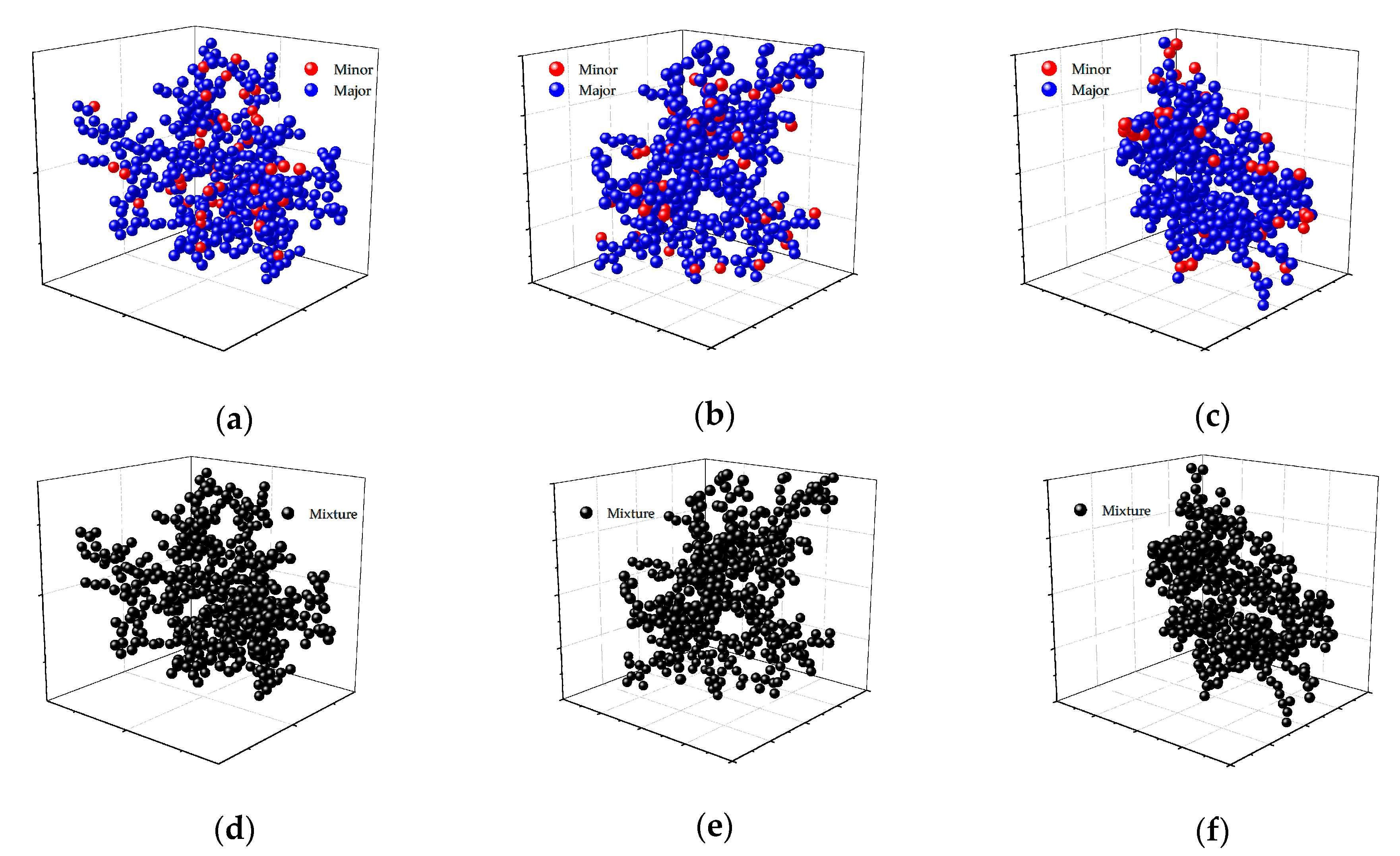
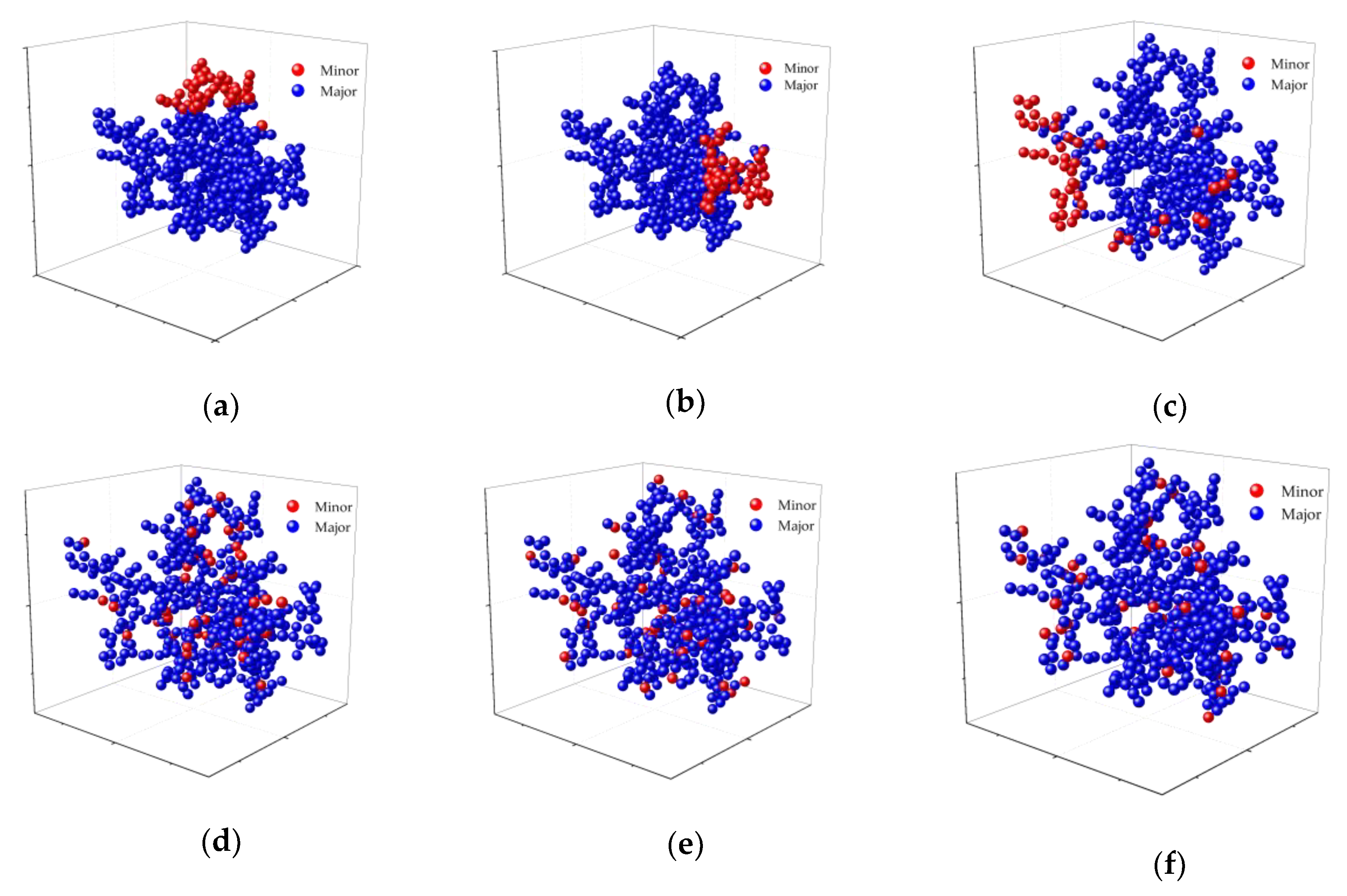
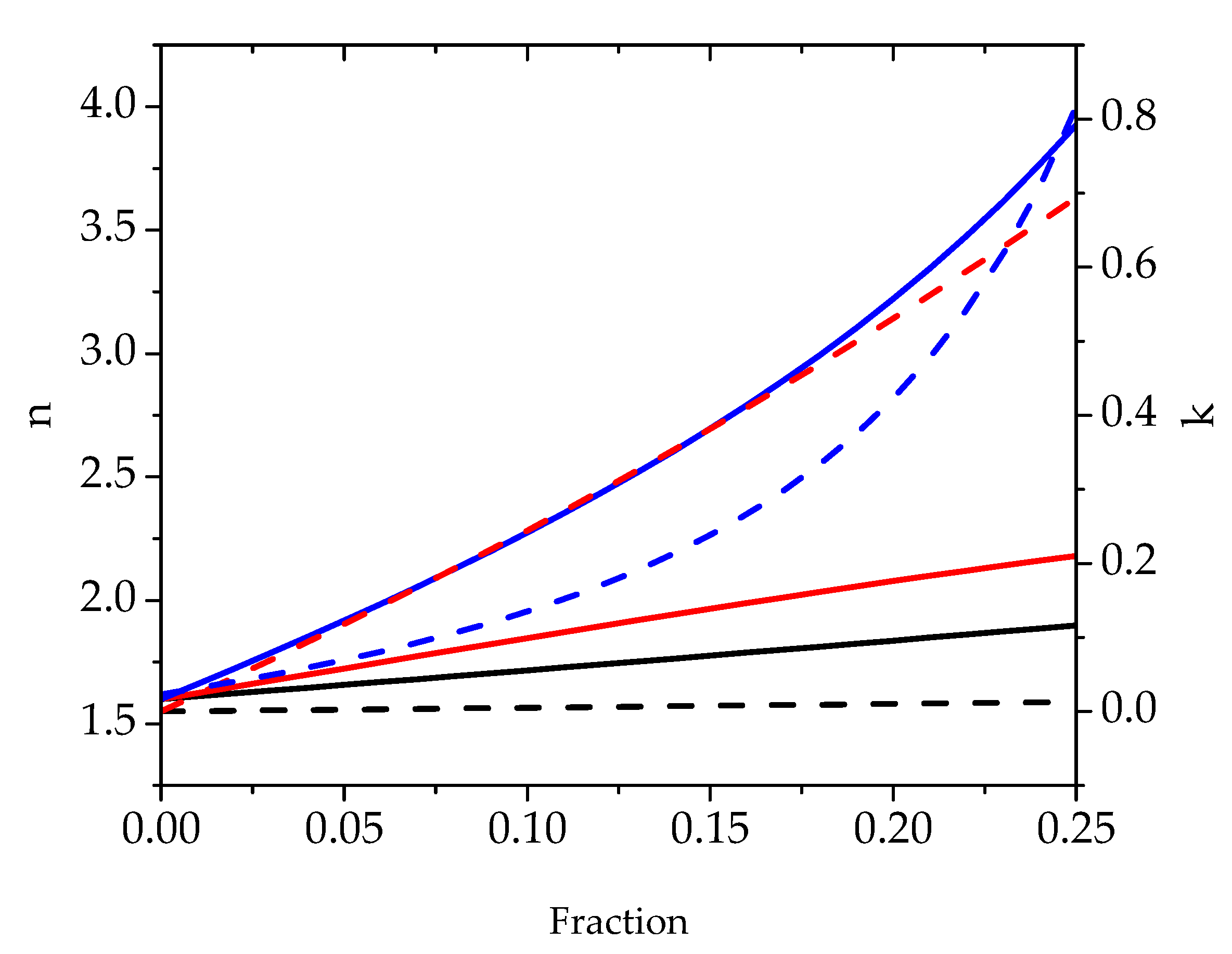
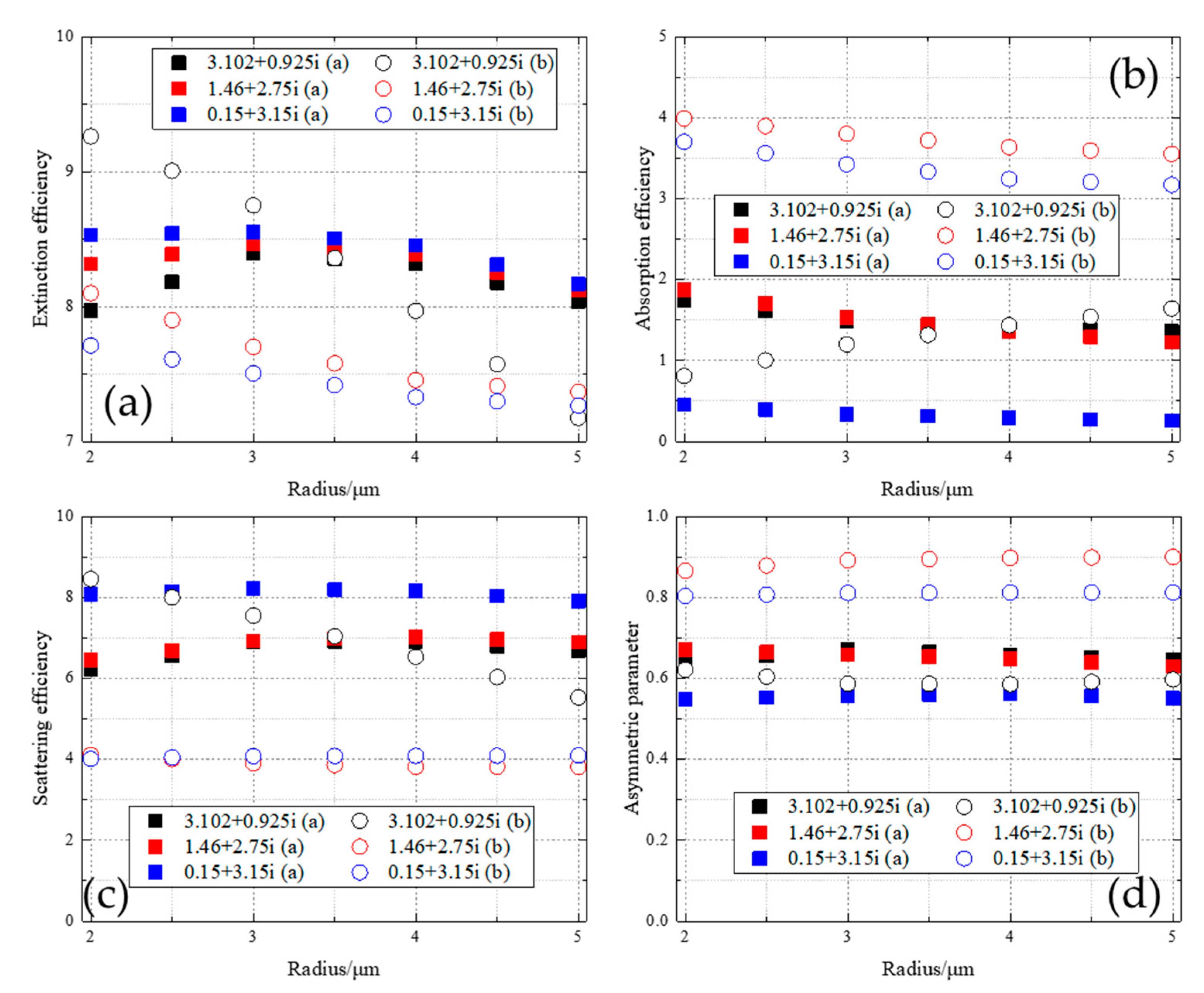
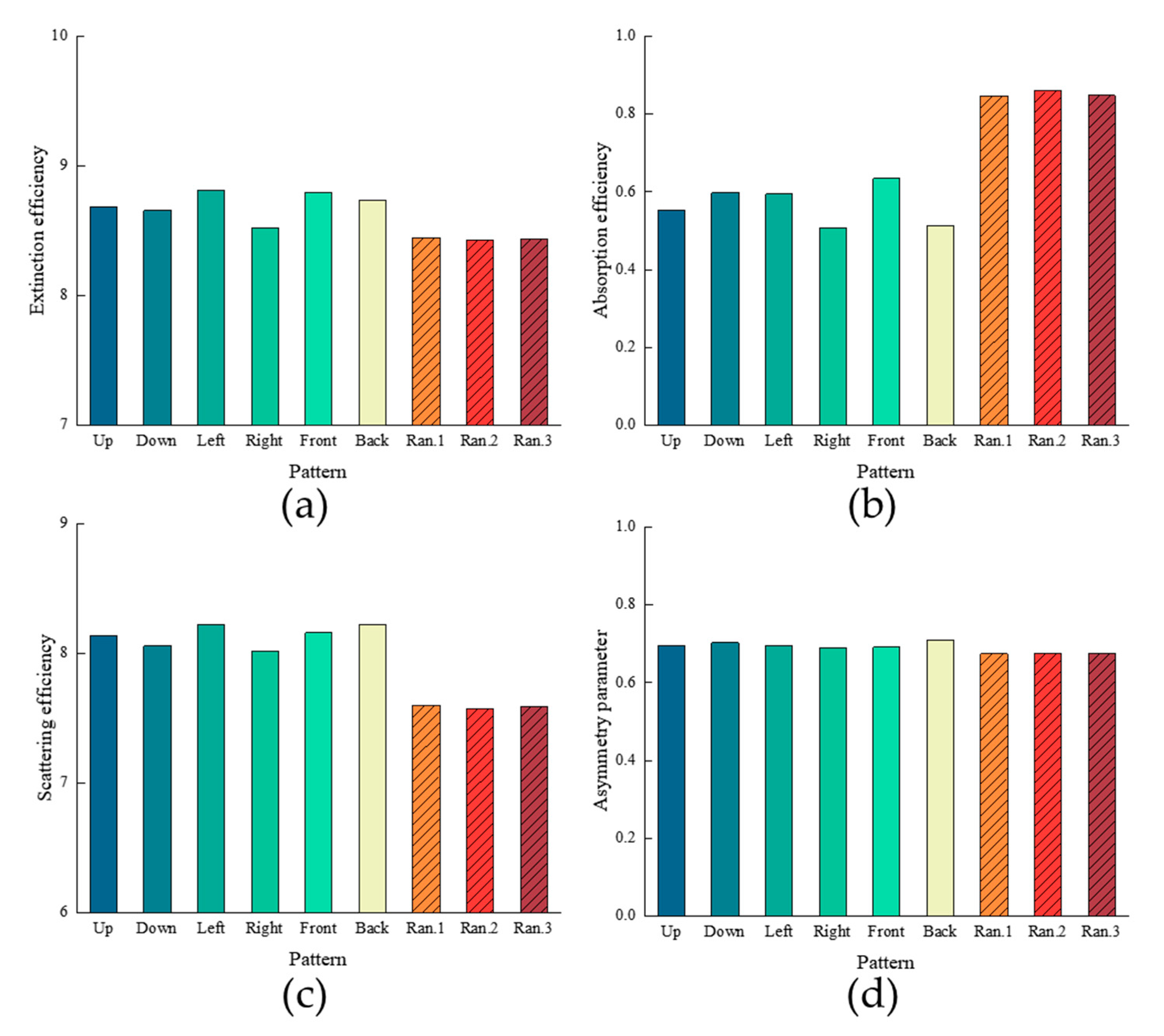
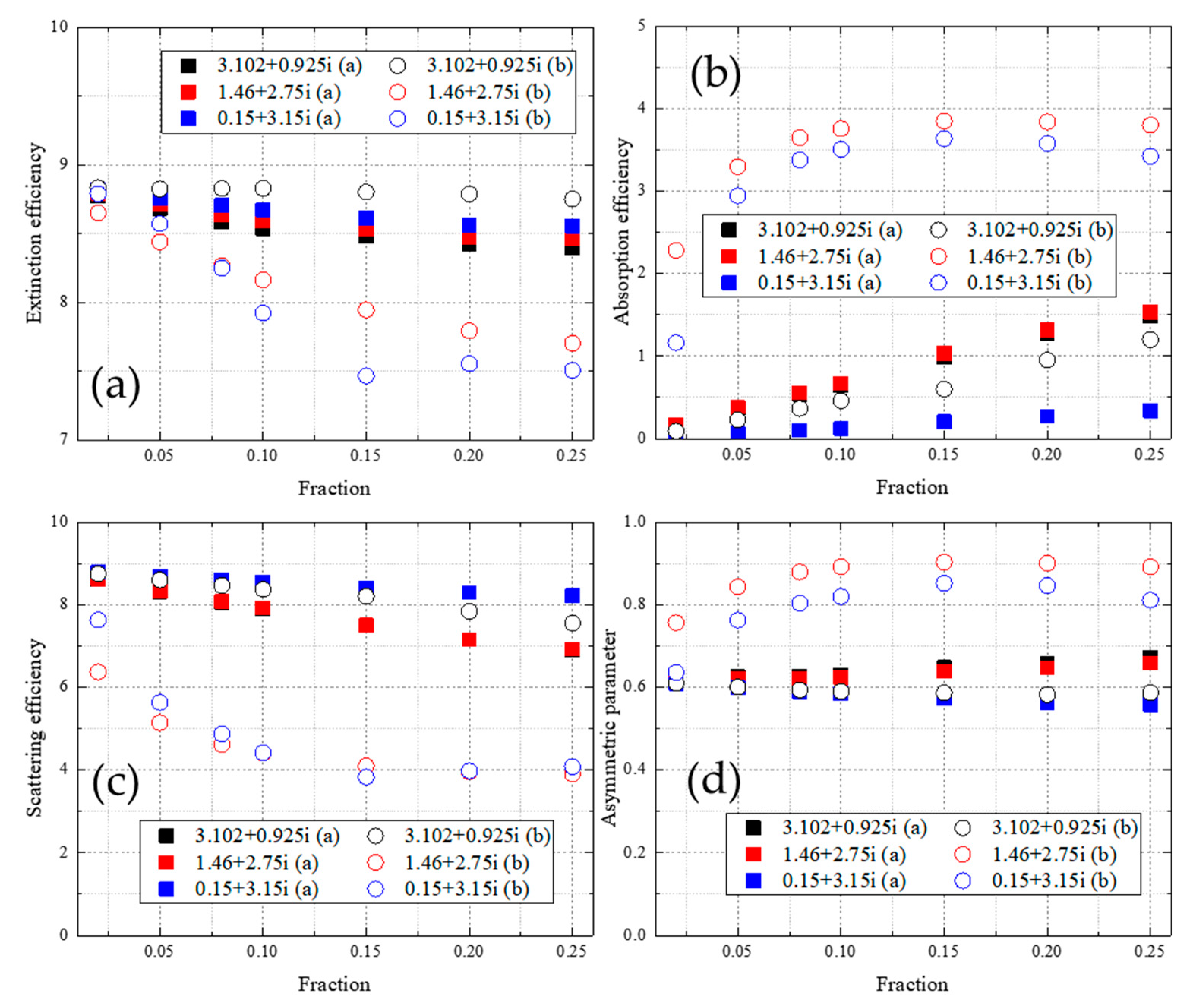
© 2019 by the authors. Licensee MDPI, Basel, Switzerland. This article is an open access article distributed under the terms and conditions of the Creative Commons Attribution (CC BY) license (http://creativecommons.org/licenses/by/4.0/).
Share and Cite
Chai, Y.; Yang, Z.; Duan, Y. The Influence of Chemical Component Distribution on the Radiometric Properties of Particle Aggregates. Appl. Sci. 2019, 9, 1501. https://doi.org/10.3390/app9071501
Chai Y, Yang Z, Duan Y. The Influence of Chemical Component Distribution on the Radiometric Properties of Particle Aggregates. Applied Sciences. 2019; 9(7):1501. https://doi.org/10.3390/app9071501
Chicago/Turabian StyleChai, Yizhan, Zhen Yang, and Yuanyuan Duan. 2019. "The Influence of Chemical Component Distribution on the Radiometric Properties of Particle Aggregates" Applied Sciences 9, no. 7: 1501. https://doi.org/10.3390/app9071501
APA StyleChai, Y., Yang, Z., & Duan, Y. (2019). The Influence of Chemical Component Distribution on the Radiometric Properties of Particle Aggregates. Applied Sciences, 9(7), 1501. https://doi.org/10.3390/app9071501





